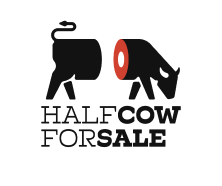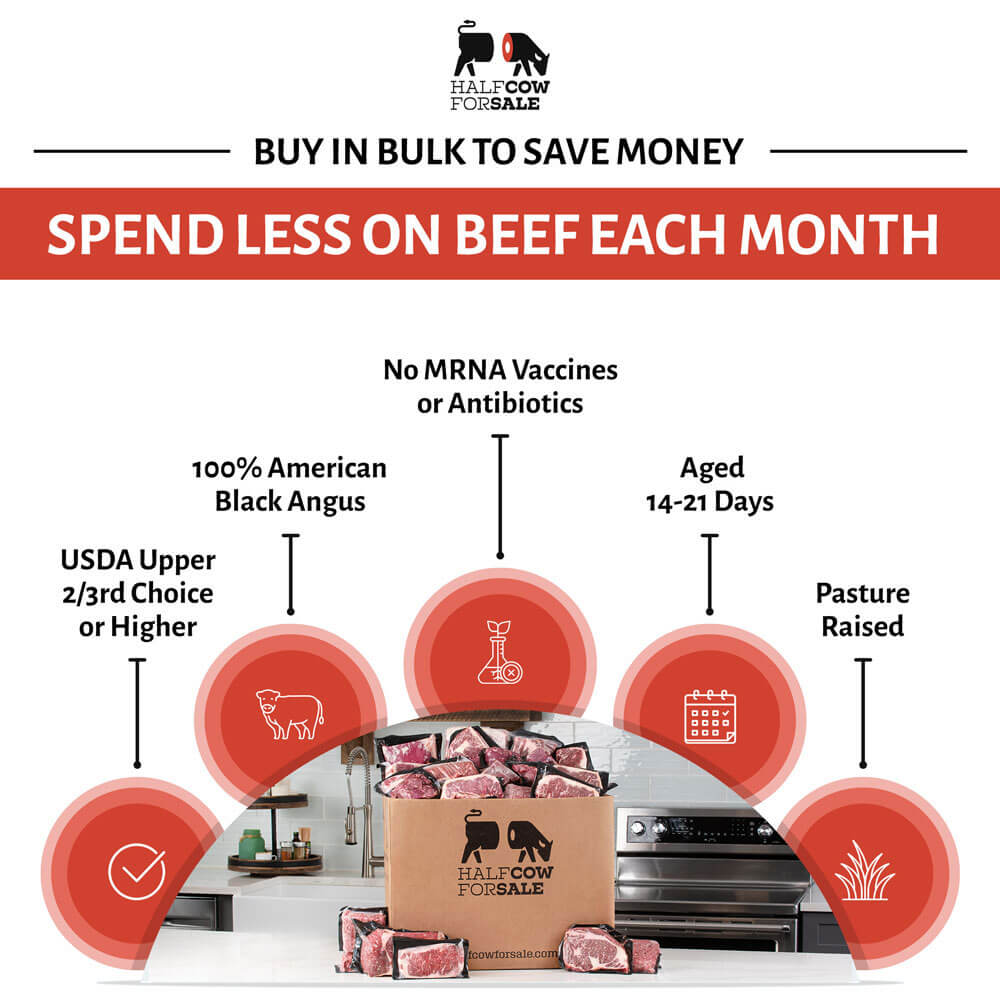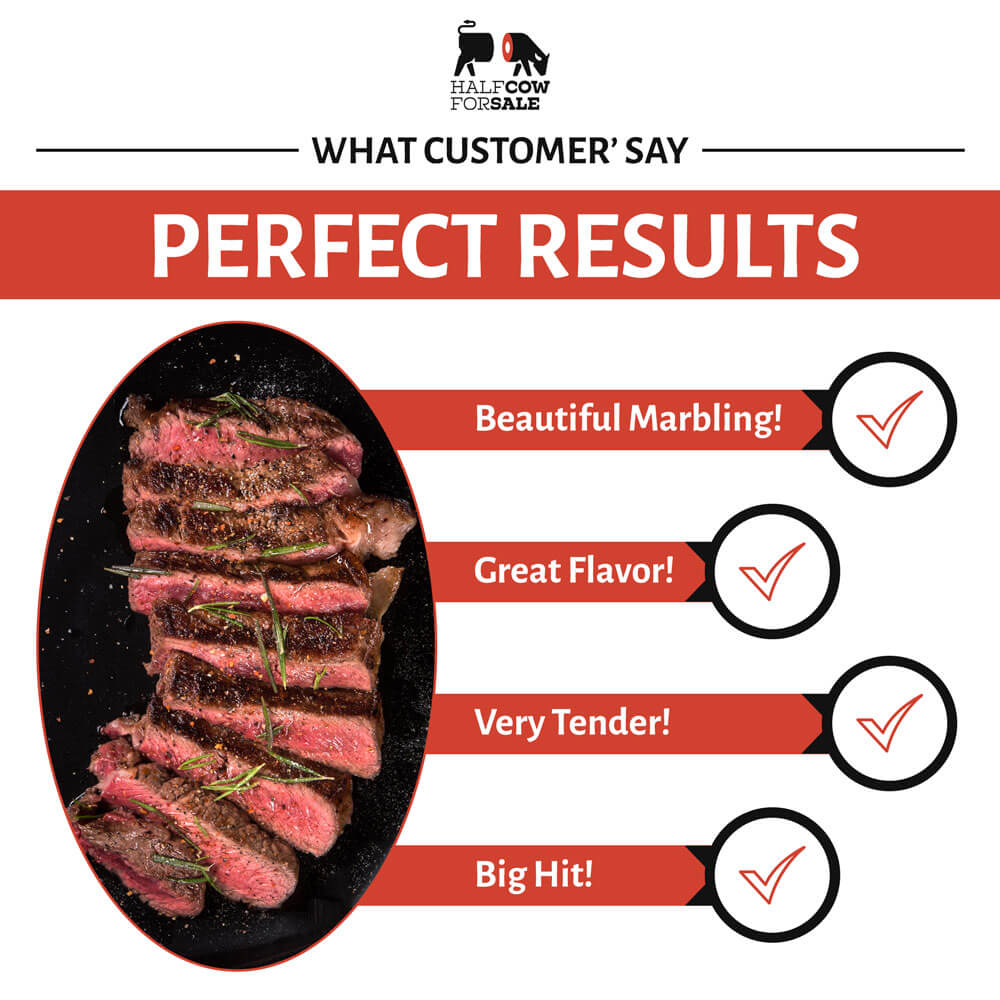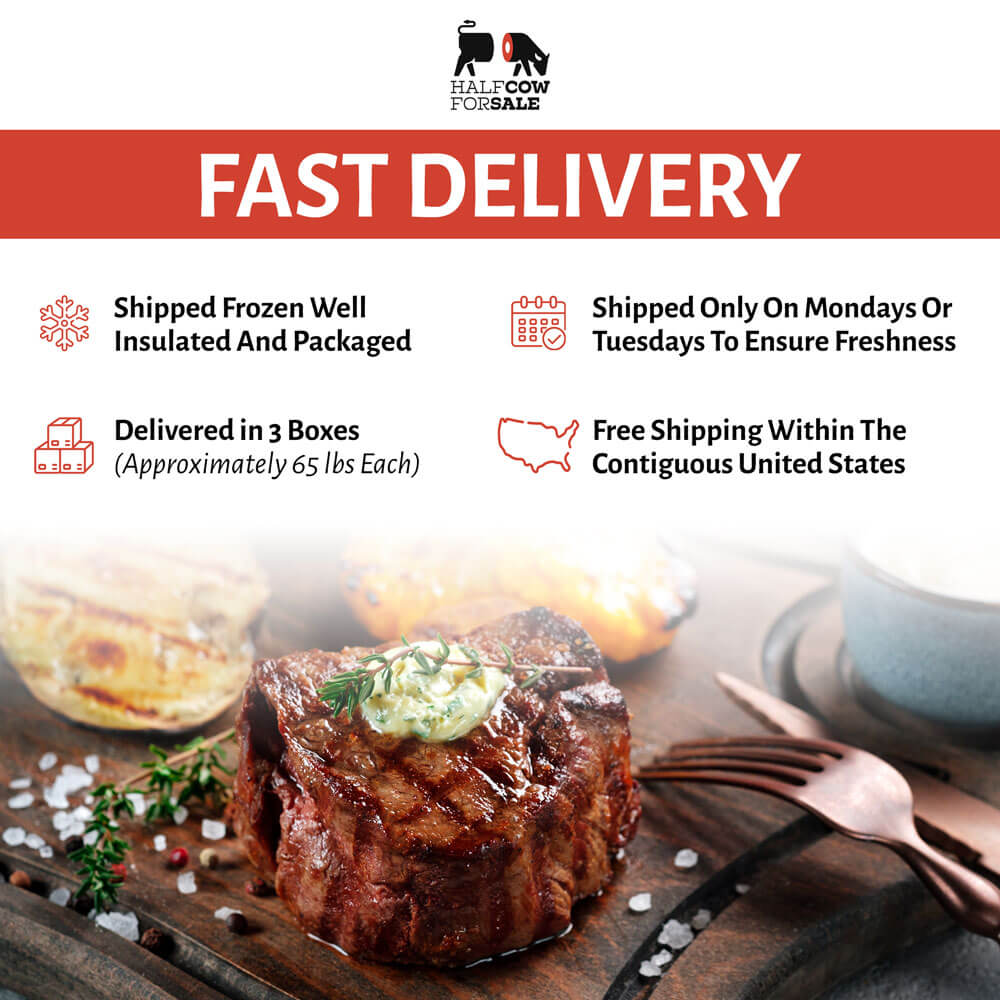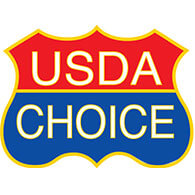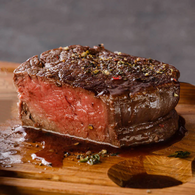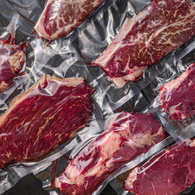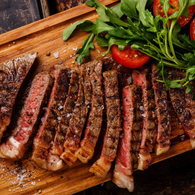
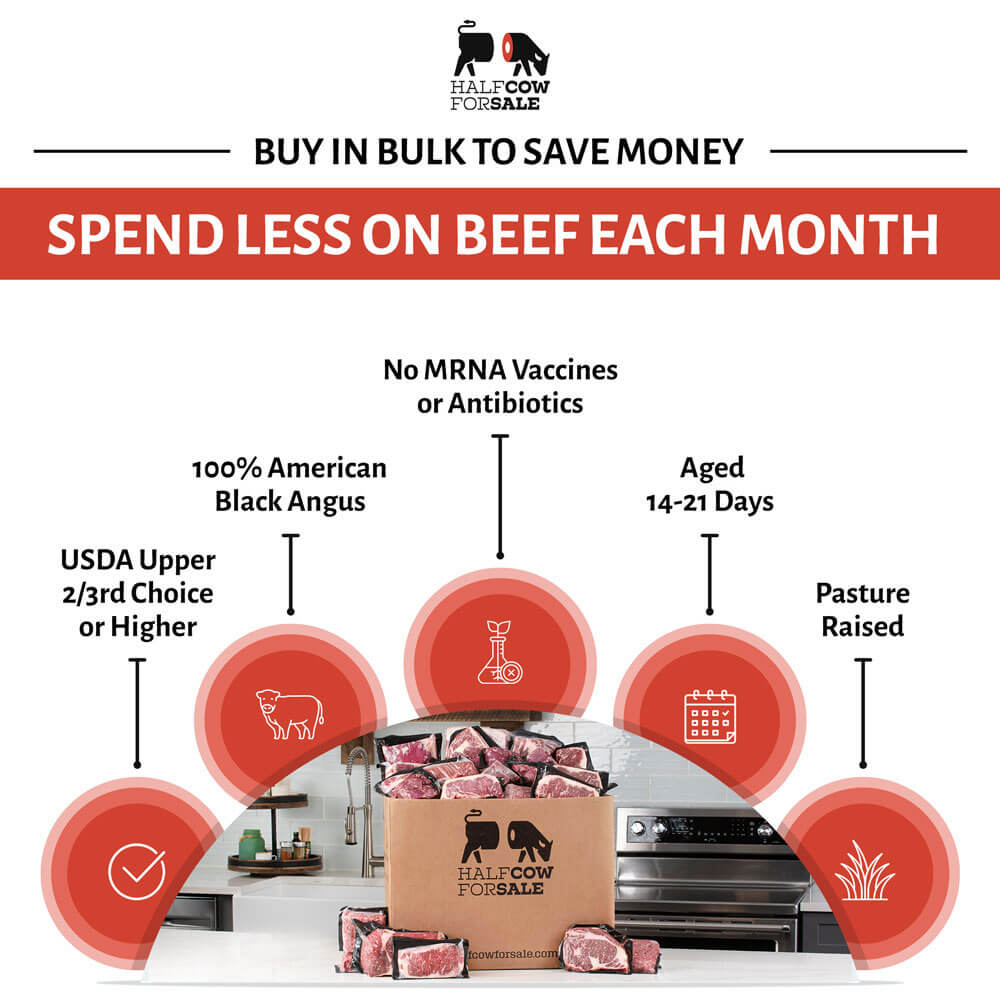

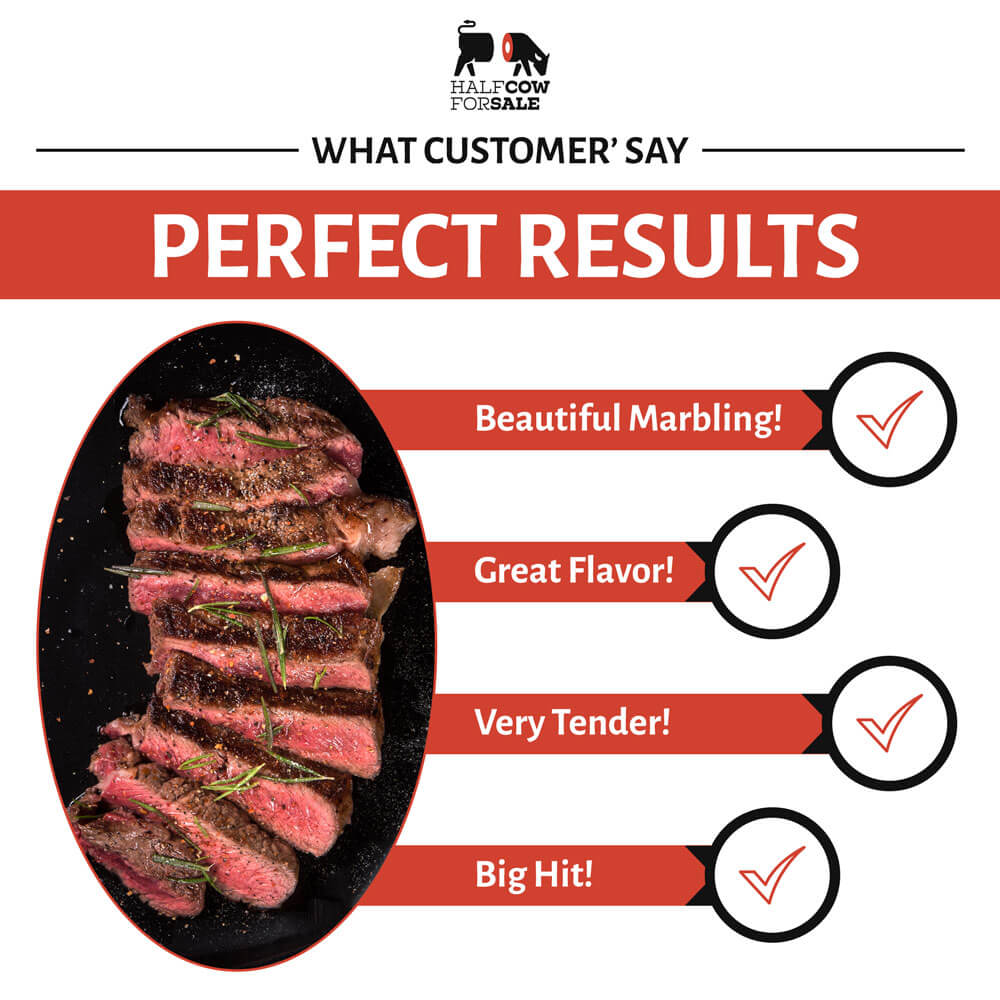
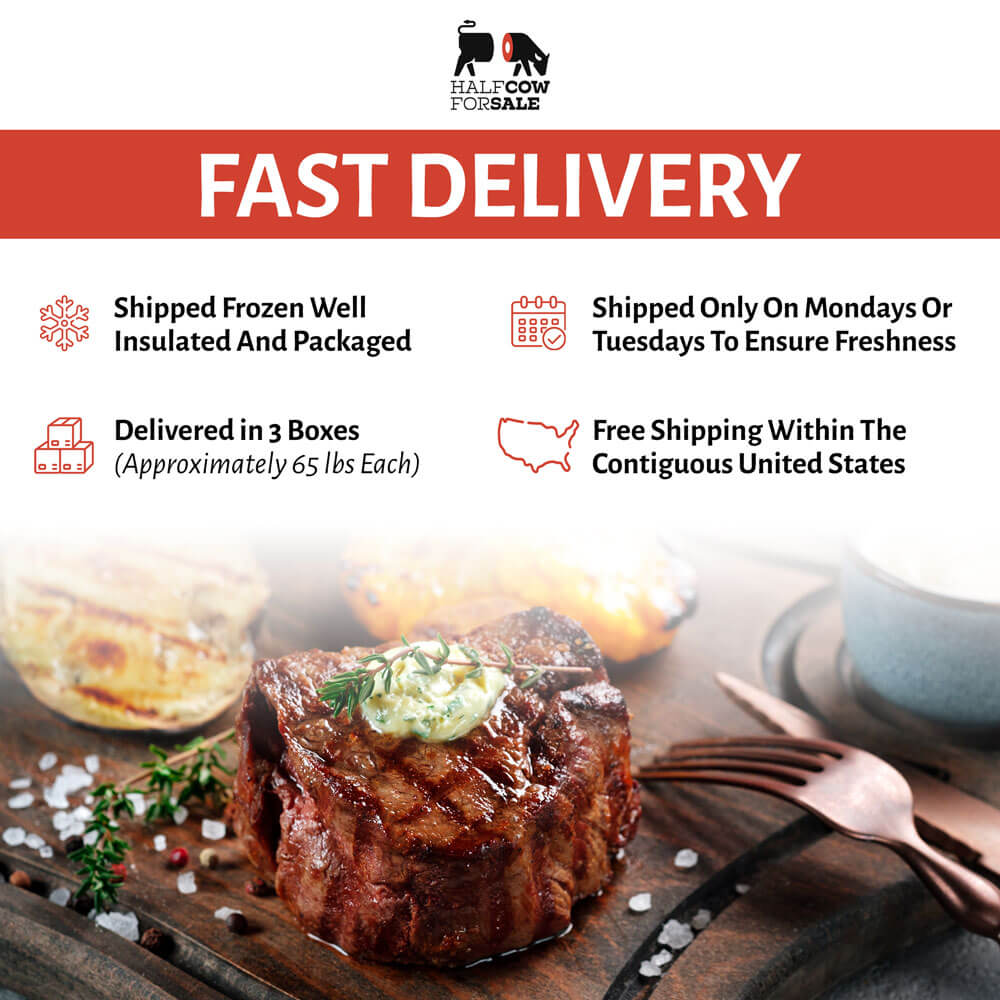

What You Get
Each individual cut is vacuum-sealed for freshness, some cuts within the half cow may be approximate see comprehensive list of cuts below.

81/19 Ground Beef w/ Full Muscle Blend
90 lbs. | 90 count

Ground Beef, Chuck & Brisket Burger Patties
1/4 lbs. | 60 count
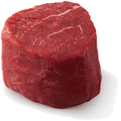
Filet Mignons
8 oz. | 6 count

Ribeye Steaks
16 oz. | 6 count

New York Strips
12 oz. | 8 count

Sirloin Steaks
8 oz. | 12 count

Brisket
12 - 15 lbs.

Flank Steak
1 lbs.

Chuck Roast
2.5 lbs. | 8 count

Stew Meat Packs
16 oz. | 8 count

Skirt Steaks
16 oz. | 4 count

Tri-Tip
2.5 lbs.

Short-ribs
3 - 5 lbs
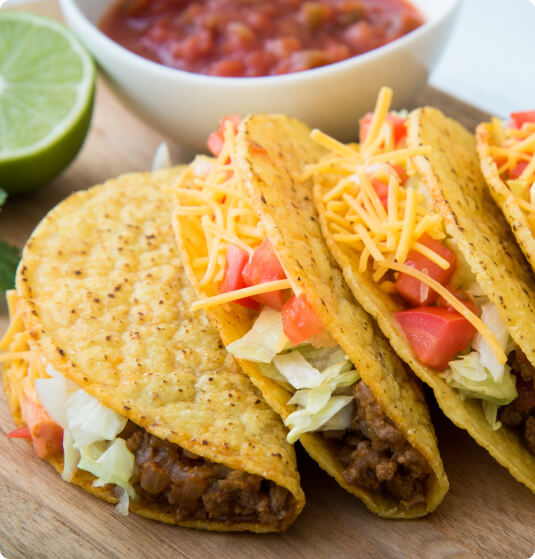
Ground Beef with Full Muscle Blend
Where it comes from: Ground beef is made from various cuts of the cow, including both front and hindquarters, using the muscle blend. It's a mixture of muscle meat and trimmings from other cuts such as chuck, round, and sirloin. It can also include other parts of the beef like the brisket or shank. The full muscle blend version is made from whole muscle cuts, ensuring a high-quality product.
Benefits of buying: Ground beef with full muscle blend is versatile and easy to cook with. It's ideal for a wide variety of dishes such as meatloaf, hamburgers, tacos, chili, and many more. Because it's made from whole muscle cuts, it often has a superior taste and texture compared to regular ground beef.
Cooking methods: Ground beef is a versatile cut and can be prepared in a variety of ways. It's often browned in a skillet for use in recipes, formed into patties for burgers, or shaped into meatballs or meatloaf. It's important to cook ground beef to a minimum internal temperature of 160°F (71.1°C) to ensure safety.
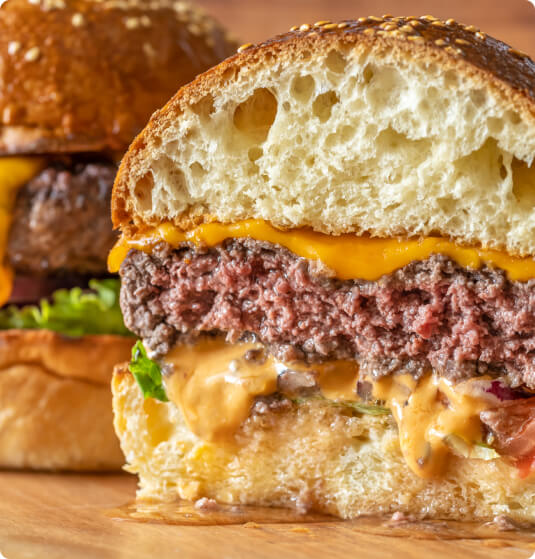
Ground Beef, Chuck & Brisket Burger Patties
Where it comes from: These burger patties are typically a blend of chuck and brisket cuts. The chuck cut is from the front part of the cow, near the neck and shoulders, while the brisket is from the breast or lower chest. Both cuts are known for their rich flavor and tenderness when cooked properly.
Benefits of buying: The combination of chuck and brisket gives the patty a balanced fat-to-meat ratio, creating a flavorful, juicy burger. Chuck provides the beefy flavor, while brisket offers a unique depth of flavor and tenderness. Buying these pre-formed patties saves time and effort in the kitchen.
Cooking methods: These burger patties are typically grilled or pan-fried. For grilling, preheat the grill to medium-high heat and cook for about 4-5 minutes on each side. If pan-frying, heat some oil in a pan over medium-high heat, then cook the patties for 4-5 minutes on each side. Always ensure that the internal temperature reaches 160°F (71.1°C) for safety.
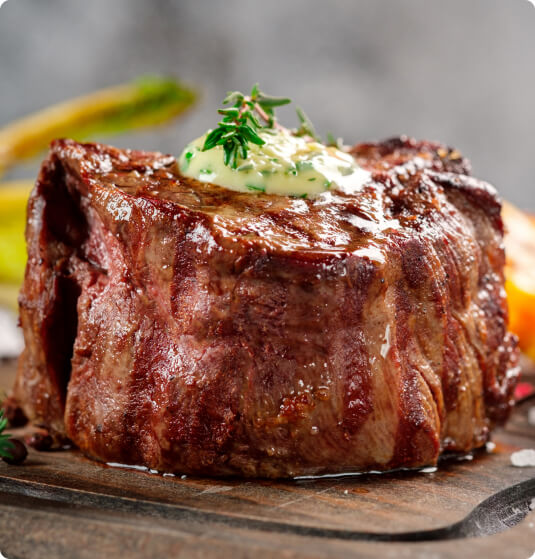
Filet Mignon
Where it comes from: Filet mignon is a cut of beef taken from the smaller end of the tenderloin, which is a long, slender cut of muscle located along the spine. The tenderloin is the most tender cut of beef, making filet mignon an extremely tender and prized cut.
Benefits of buying: Due to its tenderness, filet mignon is often considered a luxury or special occasion cut. It's lean, yet succulent, with a buttery texture that almost melts in your mouth. Since it's less marbled than other cuts, it's lower in fat while still providing a rich flavor.
Cooking methods: Filet mignon is usually cooked using dry heat methods like grilling, broiling, or pan-searing, often followed by a brief period in the oven. Due to its lean nature, it's typically cooked to no more than medium-rare to keep it from drying out. Wrapping the steak in bacon is also common to add fat and flavor.
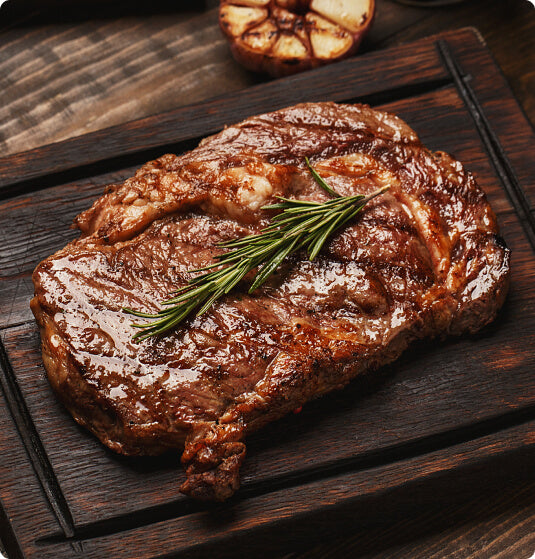
Ribeye Steaks
Where it comes from: Ribeye steaks are cut from the rib section of the cow, specifically from the longissimus dorsi muscle but also from the spinalis muscle. This cut is known for its rich, buttery flavor and juicy tenderness.
Benefits of buying: Ribeye is prized for its high degree of marbling, which gives it an excellent balance of meaty flavor and succulent tenderness. The marbling melts and bastes the meat from the inside as it cooks, creating a robust flavor.
Cooking methods: Ribeye steaks are perfect for grilling, broiling, or pan-searing due to their fat content. This cut of beef can stand up to strong flavors and pairs well with various spices and marinades. They're often cooked to medium-rare to medium to allow the fat to properly render.
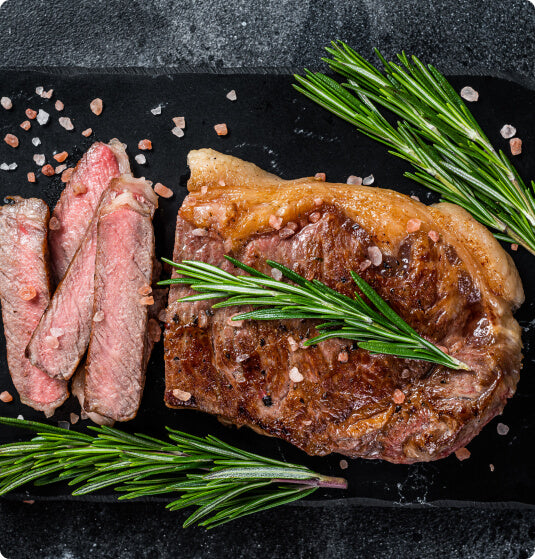
New York Strips
Where it comes from: New York strip steaks, also known as strip steaks, are cut from the short loin of the cow, specifically the longissimus muscle. This is the same muscle that continues forward to become the ribeye.
Benefits of buying: New York strip steaks are known for their balance of tender meat and flavorful marbling. They offer a beefy flavor with less fat than a ribeye but are more tender than cuts from the round.
Cooking methods: These steaks are versatile and can be cooked using various methods including grilling, broiling, or pan-searing. Similar to ribeyes, they're often cooked to medium-rare or medium to optimize their flavor and tenderness.
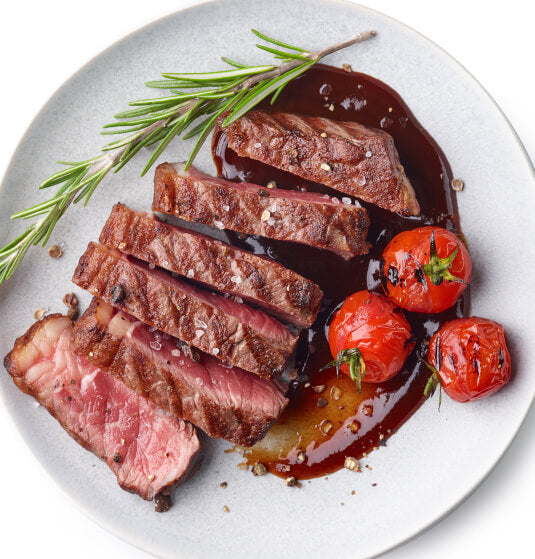
Sirloin Steaks
Where it comes from: The sirloin steak comes from the back of the cow, behind the ribs but before the rump. There are several types of sirloin including top sirloin, bottom sirloin, and sirloin tips. Top sirloin is generally the most prized and is both flavorful and lean.
Benefits of buying: Sirloin is known for being relatively lean but still very flavorful due to its proximity to the hip bone, which adds flavor during the cooking process. It's also a bit more affordable than the highly sought-after ribeye and filet mignon, making it a popular choice for many families.
Cooking methods: Sirloin steaks can be cooked using a variety of methods. They are excellent when grilled or broiled, and can also be pan-seared or roasted. They're often marinated to enhance their flavor and tenderness before being cooked to medium-rare or medium.
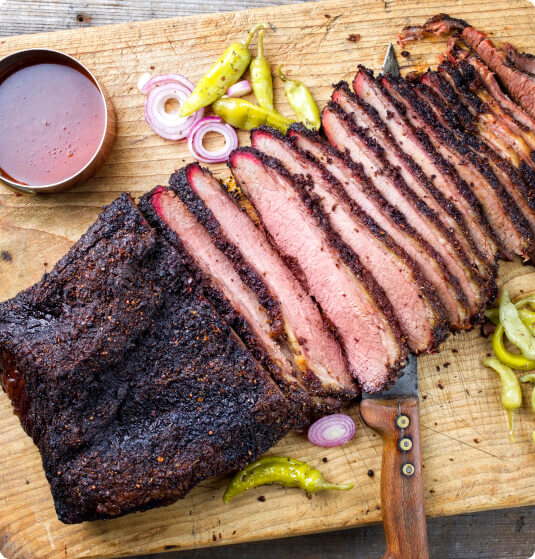
Brisket
Where it comes from: The brisket is located in the lower chest or breast of the cow. This cut is made up of two different muscles: the point and the flat. The point cut is thicker and has more marbling, while the flat cut is leaner and flatter.
Benefits of buying: Brisket is known for its rich, deep flavor and its capacity to become extremely tender when cooked properly. It's a popular choice for barbecuing, smoking, or slow-cooking, and it's the traditional choice for corned beef. The fat cap on the brisket often keeps the meat moist during long cooking processes.
Cooking methods: Brisket is usually cooked slowly at a low temperature to break down the collagen in the connective muscle tissues, which results in a very tender meat. It's ideal for slow roasting, smoking, or for use in a slow cooker. It can also be boiled as in the traditional preparation of corned beef.
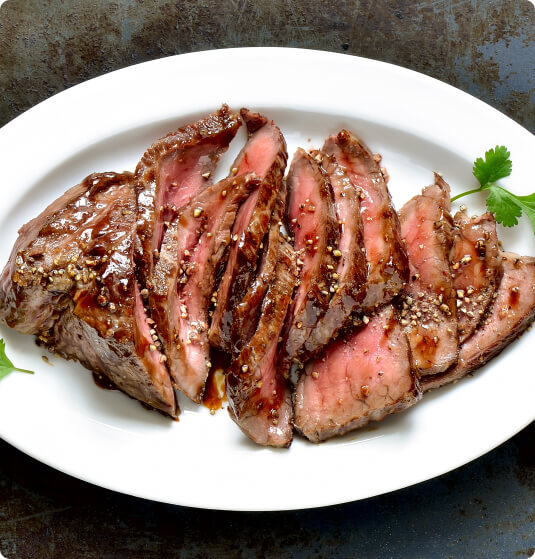
Flank Steak
Where it comes from: The flank steak is located in the abdominal area of the cow, below the loin and sirloin. It's a long, flat cut of beef with a lot of muscle fibers running through it.
Benefits of buying: Flank steak is known for its rich, beefy flavor and lean profile. It's often less expensive than other steak cuts while still delivering great taste. Although it can be tough if not prepared correctly, when cooked and sliced properly, it can be quite tender.
Cooking methods: Because of its toughness, flank steak benefits from marinating before cooking. It's typically cooked quickly on high heat, either grilled or broiled, to a medium-rare or medium doneness to prevent it from getting too tough. It's also crucial to slice flank steak against the grain (across the muscle fibers) to maximize its tenderness.

Chuck Roast
Where it comes from: The chuck roast comes from the shoulder area of the cow, a hardworking section that results in a cut full of connective tissue and rich flavor.
Benefits of buying: Chuck roast is known for its robust, beefy flavor and tenderness when slow-cooked. It's typically less expensive than many other cuts of beef, and its rich flavor and succulent texture after slow-cooking make it a staple for many classic comfort food dishes.
Cooking methods: Chuck roast is best when cooked slowly at a low temperature, allowing the tough connective tissues to break down over time. This makes it ideal for pot roasts, slow-cooker meals, stews, and braising. It's also the traditional choice for dishes like beef bourguignon.
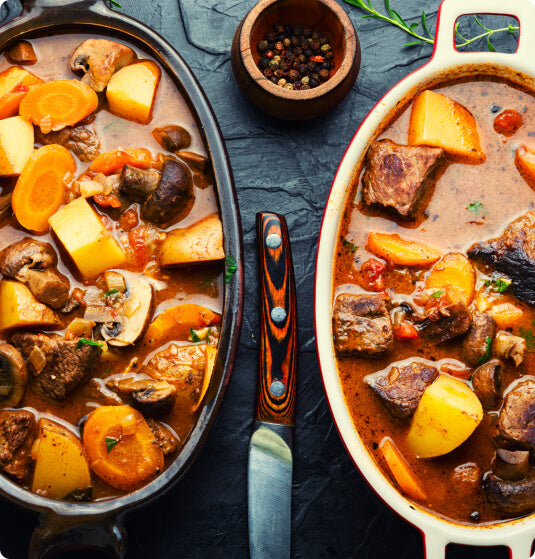
Stew Meat Packs
Where it comes from: Stew meat is usually composed of trimmings from various cuts of beef, often tougher cuts that benefit from slow, moist cooking methods. Some common sources for stew meat include the chuck, round, and brisket areas of the cow.
Benefits of buying: Purchasing pre-packaged stew meat can save you time on preparation, as the meat is already cut into bite-sized pieces. These cuts, although often tougher, offer rich, deep flavors that develop wonderfully during slow cooking. Stew meat packs can also be more economical compared to premium cuts.
Cooking methods: As the name suggests, stew meat is ideal for stews, soups, and any dish that involves slow cooking in liquid. This could include dishes like beef bourguignon, beef stew, chili, and slow-cooked curries. Slow cooking allows the collagen in these tougher cuts to break down, resulting in tender, flavorful meat.
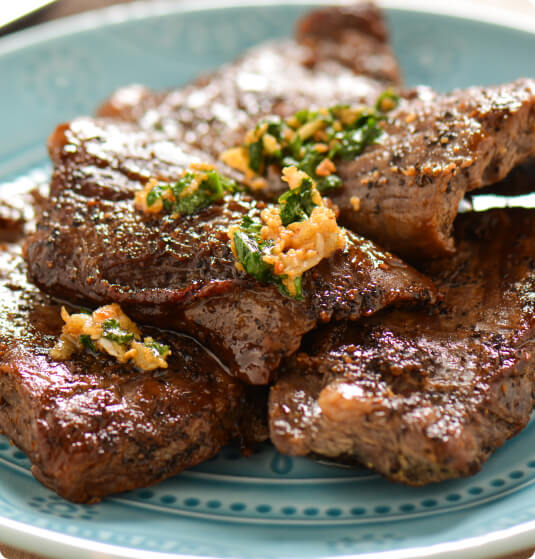
Skirt Steak
Where it comes from: The skirt steak is a long, thin cut of beef from the diaphragm muscles of the cow, specifically from the plate primal cut. It consists of two types: the outside skirt steak, which is more flavorful and tender, and the inside skirt steak, which is tougher.
Benefits of buying: Skirt steak is known for its rich, beefy flavor. It's often more affordable than premium cuts like ribeye or filet mignon, but it can deliver a robust beefy taste that's perfect for dishes where the beef's flavor needs to shine through.
Cooking methods: Because of its thinness and grainy texture, skirt steak is best when it's quickly seared or grilled over high heat to a rare or medium-rare doneness. It also benefits from marinating before cooking to help tenderize the meat. Additionally, it's crucial to cut skirt steak against the grain to enhance its tenderness.
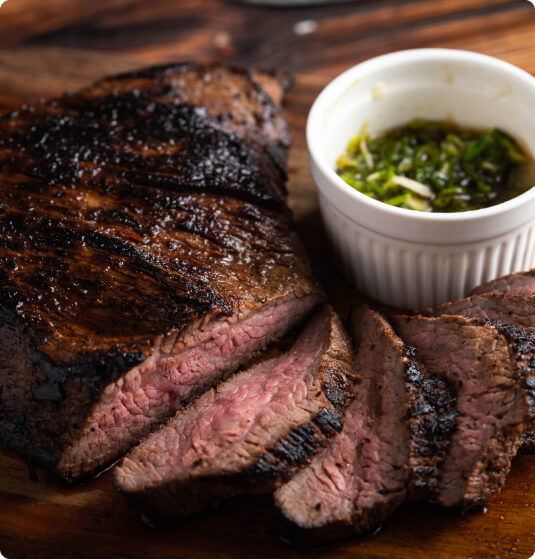
Tri-Tip
Where it comes from: The tri-tip is a small, triangular cut of beef from the bottom sirloin subprimal cut. It's named for its triangular shape and typically weighs between 1.5 to 2.5 pounds.
Benefits of buying: Tri-tip is known for its rich flavor and relatively lower fat content compared to other popular steak cuts. It offers a good balance of tenderness and flavor, and its size makes it a good choice for small gatherings or family meals.
Cooking methods: Tri-tip can be grilled, broiled, or smoked, but it's particularly well-suited to roasting or indirect grilling due to its size. Like other beef cuts, it's often cooked to a medium-rare or medium doneness. It's important to cut the tri-tip against the grain to ensure tenderness.
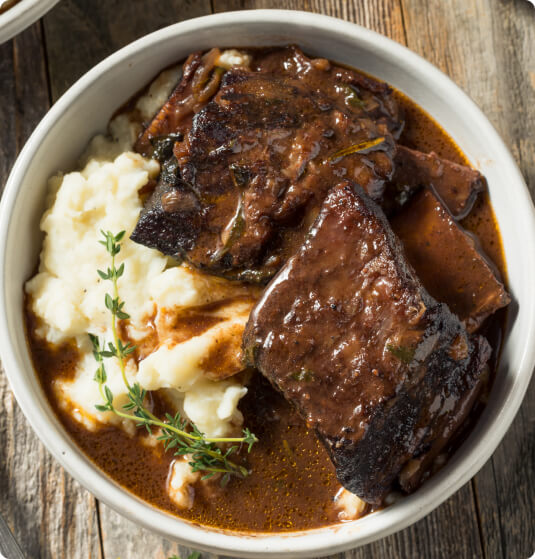
Short Ribs
Where it comes from: Short ribs come from the brisket, chuck, plate, or rib areas of the cow. These are the ends of the ribs that are cut off when rib steaks are trimmed. They contain a short section of the rib bone, which is overlain by meat and fat.
Benefits of buying: Short ribs are known for their rich, deep flavor due to the marbling of fat throughout the meat. When cooked slowly, this fat renders out and creates a tender, juicy, and extremely flavorful cut of meat.
Cooking methods: Because they contain a good amount of connective tissue, short ribs are best when slow-cooked, allowing them to become tender and flavorful. This makes them ideal for braising, slow-roasting, or slow-cooking in a crockpot.
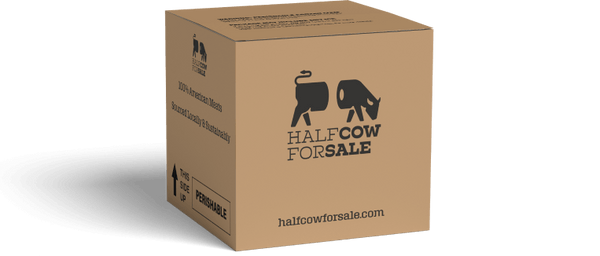
Buy a Half Cow the Smart Way
In the past, the only way to get half a cow was to have connections with a cattle farmer, go through a lot of planning with a local meat processor, wait for it to be delivered, frozen, and picked up. You would only get a front or back quarter, limiting the range of beef cuts. But with an Half Cow For Sale, the process is super easy - we do all the work and deliver you the best beef available!
- Step 1 - Place Your Order Online
- Step 2 - Delivered Packaged, Frozen, Straight to Your Door
- Step 3 - Enjoy The Half Cow
Customer Reviews Who Bought Half a Cow
Common Half Cow For Sale Questions
What does "grass-fed, grain-finished" mean?
Our cattle enjoy a life of free-roaming and natural grazing, they feed on grass pastures for the majority of their life. At the end of their life for 2-3 weeks, we introduce our homegrown whole husk grain to their diet. This practice enhances the beef's marbling and amplifies its flavor profile. We do offer a grass-finished option by special request, however, we always recommend our grain finish for maximum flavor.
What is the advantage of 14-21 days aging process?
Aging enhances the flavor and tenderness of the beef. During this process, the beef's natural enzymes break down the muscle tissue, resulting in a more concentrated, richly flavored beef with superior tenderness.
What cuts will I get with a half cow order?
Your half cow order will include the following cuts:
- 81/19 Ground Beef W/ Full Muscle Blend (90 lbs. in 1 lb. packages)
- Ground Beef, Chuck & Brisket Burger Patties (60 x 1/4 lbs. patties in 1 lb. packages)
- Filet Mignons (6 ea 8 oz. steaks)
- Ribeye Steaks (6 ea 16 oz. steaks)
- New York Strips (8 ea 12 oz. steaks)
- Sirloin Steaks (12 ea 8 oz. steaks)
- Brisket* (12 - 15 lbs.)
- Flank Steak (1 lbs.)
- Chuck Roast (8 ea 2.5 lbs.)
- Stew Meat Packs (8 ea 16 oz. packages)
- Skirt Steaks (4 ea 16 oz. packages)
- Tri-Tip (2.5 lbs.)
- Short-Ribs* (3 - 5 lbs)
*Approximate cuts are provided as ranges. Offals and soup bones available upon request.
How thick can I expect my steaks to be?
We cut your steaks to the following specifications:
- Filet Mignons - 2.25"
- Ribeye Steaks - 1"
- New York Strips - 1"
- Sirloin Steaks - 3/4"
- Flank Steak - 1/2"
- Skirt Steaks - 1/2"
Specifications are approximations, actual thickness may vary slightly in order to maintain minimum weights.
Why are two quarters cows priced less than a half cow?
The Quarter Cow doesn't include brisket, tri-tip, short ribs, flank steak, and some additional ground beef that you'll find in the Half or Whole Cows.
For those seeking added value and a genuine taste of American barbecue, the Half Cow with all cuts is the ideal choice.
How does your shipping process work?
We offer fast, free shipping and dispatch half cow orders every Tuesdays & Wednesday morning CST. If you place an order after the weekly cut-off time, it will be scheduled for delivery on the following Tuesday.
What does it mean that your beef is sustainably sourced?
Sustainably sourced means that we follow farming practices that are environmentally friendly, socially responsible, and economically viable. Our cattle are born, raised, and harvested 100% here in the United States, reducing animal stress and lowering our carbon footprint.
Weight & Cuts
| Cuts | Ground Beef W/ Full Muscle Blend | Ground Beef, Chuck & Brisket Burger Patties | Filet Mignons | Ribeye Steaks | New York Strips | Sirloin Steaks | Brisket | Flank Steak | Chuck Roast | Stew Meat Packs | Skirt Steaks | Tri-Tip | Short-Ribs |
|---|---|---|---|---|---|---|---|---|---|---|---|---|---|
| Weight | (1 lbs.) | (1/4 lbs.) | (8 oz.) | (16 oz.) | (12 oz.) | (8 oz.) | (12 - 15 lbs.) | (1 lbs.) | (2.5 lbs.) | (16 oz.) | (16 oz.) | (2.5 lbs.) | (3 - 5 lbs) |
| Quarter Cow | 30 | 20 | 3 | 3 | 4 | 6 | - | - | 4 | 4 | 1 | - | - |
| Half Cow | 90 | 60 | 6 | 6 | 8 | 12 | 1 | 1 | 8 | 8 | 4 | 1 | 1 |
| Whole Cow | 180 | 120 | 12 | 12 | 16 | 24 | 2 | 2 | 16 | 16 | 8 | 2 | 2 |
Other Half Cow Sizes
-
Whole Cow For Sale Dry-Aged Grass Fed Grain Finish 100% American Black Angus
Rated 4.9 out of 5 stars98 ReviewsRegular price $5,750.00Regular priceUnit price per$7,500.00Sale price $5,750.00Sale -
Half Cow For Sale Dry-Aged Grass Fed Grain Finish 100% American Black Angus
Rated 4.9 out of 5 stars98 ReviewsRegular price $3,195.00Regular priceUnit price per$3,800.00Sale price $3,195.00Sale -
Quarter Cow For Sale Dry-Aged Grass Fed Grain Finish 100% American Black Angus
Rated 4.9 out of 5 stars98 ReviewsRegular price $1,189.99Regular priceUnit price per$1,399.99Sale price $1,189.99Sale -
Try It You'll Love It Bundle + Complimentary $100 In Free Gift Vouchers*
Rated 4.9 out of 5 stars98 ReviewsRegular price $129.00Regular priceUnit price per$129.00Sale price $129.00
A La Carte Offers
-
Dry Aged Boneless Prime Rib - Pasture Raised Antibiotics Free
Rated 4.9 out of 5 stars126 ReviewsRegular price From $189.00Regular priceUnit price per$189.00Sale price From $189.00 -
Add (2) Bone-In Dry-Aged Tomahawk Ribeyes
Rated 4.9 out of 5 stars126 ReviewsRegular price $339.00Regular priceUnit price per$339.00Sale price $339.00 -
Add (10) Premium Steaks - Bulk Steaks Box
Rated 4.9 out of 5 stars126 ReviewsRegular price $429.00Regular priceUnit price per$429.00Sale price $429.00
